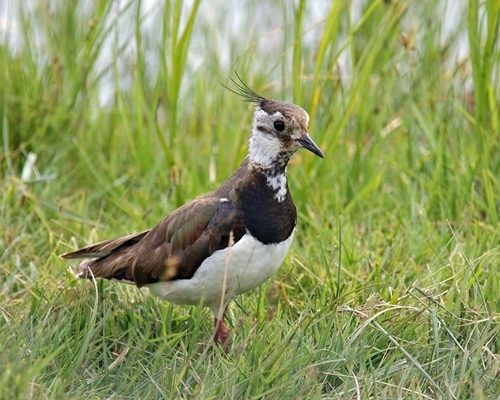Key findings
- Lapwings and redshank are more likely to breed on land managed under the higher ESA tiers than on non-agreement land.
- The future of lapwings and redshank in the Avon Valley will depend on uptake of ESA measures.
- There is no evidence that ESAs are benefiting snipe.
 There has been a severe decline in numbers of breeding lapwings, redshank and snipe in lowland England and Wales since the early 1980s. For the UK as a whole, the lapwing is ‘red-listed’ as a bird of conservation concern owing to population declines and the redshank and snipe are ‘amber-listed’. Historically, wet grassland sites have been important strongholds for breeding waders in the lowlands, including river valleys, such as the Arun, Avon and Test valleys, as well as grazing marshes such as the North Kent Marshes and Somerset Levels. However, at many of these sites, particularly those not managed as nature reserves, changes in landscape character and agricultural management have resulted in declining wader populations.
There has been a severe decline in numbers of breeding lapwings, redshank and snipe in lowland England and Wales since the early 1980s. For the UK as a whole, the lapwing is ‘red-listed’ as a bird of conservation concern owing to population declines and the redshank and snipe are ‘amber-listed’. Historically, wet grassland sites have been important strongholds for breeding waders in the lowlands, including river valleys, such as the Arun, Avon and Test valleys, as well as grazing marshes such as the North Kent Marshes and Somerset Levels. However, at many of these sites, particularly those not managed as nature reserves, changes in landscape character and agricultural management have resulted in declining wader populations.
The Avon Valley between Salisbury and Christchurch provides an example of the changes and pressures facing breeding waders in lowland England. Parts of the valley have SSSI and SPA designations reflecting their value for a wide range of species, including breeding waders, wintering wildfowl, otters and certain insects, molluscs and plants of national importance. Since 1993, an ESA scheme has operated in the valley to encourage wildlife-sensitive farming, superseded in 2003 by the Environmental Stewardship scheme. We have conducted periodic surveys of waders in the Avon Valley since the early 1990s and since 2007 we have conducted more intensive studies to assess lapwing breeding success and the effectiveness of agri-environment measures at reversing lapwing population declines.
Surveys on about half the available wet grassland within the valley suggest that between 1990 and 2010 lapwing numbers declined from 208 to 71 pairs, redshank from 117 to 22 pairs and snipe from 29 displaying males in 1990 to none currently. Reasons for these declines are complex and inter-related and there may be subtle differences between the species which our relatively crude habitat measures do not fully explain. However, substantial changes in landscape character and livestock numbers since the early 1980s have undoubtedly been important.
Currently, inappropriate water levels, resulting in a rapidly drying soil surface in spring or leading to summer floods, and an increasing polarization of sward conditions towards intensively grazed short swards or rank areas with scrub encroachment, are the most pertinent habitat issues. The change in swards stems from a large reduction in the number of livestock within the valley during the last 20 years, with a shift from dairy herds to beef cattle. While farmers experienced some difficulties with ESA prescriptions and there were some issues with compliance, wader densities are currently higher where habitat is being managed under HLS. For instance, lapwing densities average 0.25 ± 0.05 pair/ha on HLS fields compared to 0.13 ± 0.01 pair/ha on fields not within the scheme. However, low productivity, even on areas where habitat is more suitable, seems to underlie the ongoing declines.

We have studied the lapwing population in the valley in more detail in recent years because, of the three wader species, the lapwing is the easiest for which to assess breeding success, but also because we know from analyses of ringed birds that the driver of declines is poor productivity and not reduced adult survival. Fledging of at least 0.70 young per pair, on average, is required for maintenance of a stable breeding lapwing population, but in the Avon Valley this level of productivity has been achieved just once in the last seven years. We found no statistical difference in productivity between fields managed under HLS and fields not entered in an agri-environment scheme.
2011 was an exceptional year with a very dry spring and lapwing productivity was poor at breeding sites across the country, including nature reserves. Ignoring 2011, brood survival rate was reasonable and nest predation appears to be the main issue. Data from miniature temperature loggers in 39 predated nests revealed, through rapid changes in nest temperature, that 49% of nests were predated at night, and hence were likely to have been taken by mammals, with 41% taken during the day, most likely by corvids or gulls. Only 10% were predated during twilight at dawn or dusk, when both corvids and foxes could be active. Nest predation rates varied appreciably between farms and between years on the same farm, but, on average, they are currently too high for maintenance of a stable lapwing population within the Avon Valley as a whole. We estimate that without immigration of lapwings from elsewhere, the valley population is likely to decline by 50% in the next five years.
Clearly, maintaining or restoring appropriate habitat is essential, but, at least in the short-term, some relief from predation seems necessary to enable populations to recover. Our aim, if breeding waders are the principal focus of conservation management, should be increasing, not just stable, local populations and to achieve this requires productivity well above 0.70 young per pair. We are planning an experimental approach to evaluate the most efficient and targeted solution to reducing wader predation in lowland river valleys.